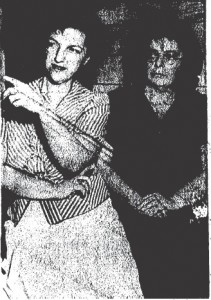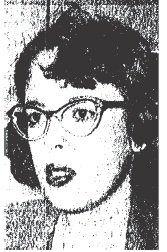 The biggest manhunt since the murder of Elizabeth Short continued as cops tried to find the killer of hairstylist Louise Springer.
The biggest manhunt since the murder of Elizabeth Short continued as cops tried to find the killer of hairstylist Louise Springer.
LAPD conjectured that either Louise Springer had been immediately stunned with a blunt instrument as she sat in her car at a Crenshaw Blvd. parking lot, or she had known the person who murdered her. The two possible theories were supported by the fact that Louise had apparently offered no resistance, nor had she cried out — and, tellingly, her brand new manicure was still pristine.
There were bruises on Louise’s right temple and the top of her head which, in the opinion of Dr. Frederick D. Newbarr, the autopsy surgeon, were hard enough to render her unconscious.

Mrs. Jewell Lorange, left, and Miss Germaine Le Gault presented possible clue to slaying of Mrs. Louise Springer in reporting “three men in black car.”
Of the scant leads uncovered by detectives, an interesting piece of information emerged. Miss Germaine Le Gault and Mrs. Jewell Lorange, who lived directly across from where the death car was found, said that they saw three men “in a big, black car” spend two evenings prior to the murder parked less than 50 feet away from where Springer’s strangled body was found. Unfortunately, the lead never panned out.
More than a week had passed when suddenly the Springer case began to heat up with the arrest of two suspects: Leon Russell, car washer at a service station near the parking lot, and Claud Cox, a jobless Navy vet who had been arrested on a morals complaint made by a young Hollywood woman named Marion Brown. Brown, 18, told cops that Claud Cox, whom she said she knew slightly, took her to his room at 1611 N. Orange Drive and tried to molest her. Cox told cops that he got “a little friendly” but he flatly denied trying to harm the girl.
As cops tracked down leads, Louise Springer’s husband and her 21 month old son mourned the wife and mother as she was laid to rest in a San Jose cemetery.
At least the crime lab was finally able to state conclusively that Louise Springer had not been slugged before she was garroted in her husband’s car. What had initially appeared to be bruises on Mrs. Springer’s head were actually post-mortem tissue changes — the result of the dead woman’s body resting face down for three days in the backseat of the car before being discovered. The evidence suggested that Springer had been murdered in the car, at the parking lot, as she listened to the radio.
Another suspect was arrested and cleared by LAPD homicide detectives. The man was thirty-eight year old Guy Smith who was busted by L.A. Sheriff’s department deputies on a tip from a relative. Nobody can do you dirt like family. In any case, Smith had an alibi for the time of Louise’s murder; however, the law was investigating him in connection with other unsolved crimes, notably morals offenses.
As the case grew colder the cops began to cast around for a new motive in Louise’s murder. Maybe kidnapping and sexual assault weren’t the real motives; maybe someone had a grudge against her, or they were jealous of the attractive brunette.
 One of the early suspects in Springer’s murder, Claude Cox, was arrested in September 1949, but the arrest had nothing to do with Louise Springer’s death. According to Mrs. Geneva Cowen, 35, she was walking along Hollywood Blvd. when she heard someone come up behind her. She turned and the man, Claude Cox, rushed up and hit her, hard. Cox said: “I’m going to kill you.” Cowen took a chance and started to run. Cox grabbed for her, but only succeeded in pulling her coat off.
One of the early suspects in Springer’s murder, Claude Cox, was arrested in September 1949, but the arrest had nothing to do with Louise Springer’s death. According to Mrs. Geneva Cowen, 35, she was walking along Hollywood Blvd. when she heard someone come up behind her. She turned and the man, Claude Cox, rushed up and hit her, hard. Cox said: “I’m going to kill you.” Cowen took a chance and started to run. Cox grabbed for her, but only succeeded in pulling her coat off.
Eventually the leads dried up and the Louise Springer murder, aka, the Green Twig Murder case, went cold.
Laurence and Louise Springer had been in L.A. for only six months before she was murdered, so the widower returned to Northern California to try to put some of his pain behind him.
The single major success in the case came when Dr. Mildred Mathias, UCLA botanist, was finally able to identify the twig that had been so cruelly inserted into Louise Springer’s vagina as belonging to a bottle tree. Dr. Mathias said that the twig had apparently been stripped from a larger branch sometime in the year prior to the crime.
Louise Springer’s murder remains unsolved.


So Dr Mathias is saying the killer was walking around for a year with this twig on his person? They found no fingerprints in the car? Fingerprinting or lack there of seemed to be a problem back then.
There were probably lots of bottle brush plants around, but when and where the perp picked up the twig never seems to have
been addressed. Kind of odd. I believe they would have dusted for prints, but just never came up with a suspect who
matched. Also, it seems like contaminated crime scenes were more the rule than the exception then. There would be cops
and reporters and who knows who else milling around, smoking, it’s a miracle some of the crimes were solved at all.
Was it a bottle tree, or a bottlebrush tree?
As far as I can tell the botanist who examined the twig referred to it only as coming from a bottle tree She said it was often used as a street tree. It was likely a Brachychiton populneus. Hope this helps. — Joan
The tree did it !!! That Bottle tree is using an alias.His real name is Kurrajong.
Nope — the tree had an alibi. Turn in your badge.
There were more suspects for this crime. Witnesses said that the Springer’s parked car was left by a tall, curly hair man. Even writer Steve Hodel mentioned this on his web-page and book on the Black Dahlia. What is omitted is that these witnesses also said the suspect was wearing a navy uniform. On June 17, 1949 a 23 year old Ralph Kyle was arrested in the case for matching the description and in proximity to the murder scene.
David,
You’re right, there were dozens of suspects for Louise Springer’s murder. One of them was James H. Williams, Glendale service station attendant. He was ceared as suspect after he was arrested for an alleged sexual assault on a woman in Montrose.
On June 18, 1949, the Los Angeles Times reported on the suspect you mentioned.
“The suspect, Ralph Kyle, 23, was picked up at 14th and Santee Sts., when Radio Officers E.S. Bogardus and R.S Rapler found him changing from a Navy warrant officer’s uniform to “civvies” in his 1942 sedan. Don Graham, 25, of 145 W 38th St. had told of seeing a man in Navy officer uniform get out of the Springer car and walk away.
Kyle, former electrician on a submarine, was held four hours while police checked out his story he was jobless and slept in his car. He explained he was in the Navy Reserve and “likes” to wear the uniform. Police also were interested in a length of clothesline-type rope found in the trunk of his car.
The rope, however, did’t match the knotted murder cord looped twice around Mrs. Springer’s slender throat,, and a check of Kyle’s movements and record caused authorities to release him.”
As far as I can tell, Steve Hodel dismisses anything that doesn’t support his theory that his father was a serial killer mastermind. I imagine the man in uniform sighting is another casualty of his theory.
Another suspect was confessed Utah sex slayer, Ray Dempsey Gardner, 27. Thad Brown, Asst Police Chief, LAPD, indicated Gardner needed to account for his whereabouts during the time of other unsolved murders of women in Los Angeles. We must presume that he was cleared of the LA crimes. However, he was executed by firing squad in Utah on July 29, 1951. His last words were “No one will miss me. My life has been worthless.” His grandmother agreed. She declined the offer to have his body shipped to Ohio, “. . . his mother is dead. We knew nothing about him for eight years until we read of him committing the crime . . . I have no further responsibility of care. Use the body as the law directs for medical science.”
Thank you for writing!
Joan
I will let to say that I do not believe that this case and the black dahlia case are connected other then a co conspirator in the black dahlia murder killed Louise Springer and I believe the same man killed crime writer James ellroy mother 11yrs later and the man I believed killed both of these women was the same man who created the Maltese falcon bird for the movie the Maltese falcon and his name was Fred Raphael sexton he was a la artist who was best friends with George hodel since they was teens plus sexton moved all around la and Mexico plus he fit jean ellroy killer composite sketch to the tee and his hair matches the witnesses statement in how Louise Springer killer looked a dark curly hair man that matches sexton hair as well
I do not see George hodel as being her killer Louise Springer his incest trial has not proven that he was a pedophile pervert not excluding that he wasn’t I am just saying it didn’t prove it but I will say that the evidences that his son Steve hodel has presented shows more of his being a homicidal monster who brutal murdered Elizabeth Short by means of. His highly qualified surgical skills and as I also calme to know that he did not rape her or any a attempt but if u look at his childhood friend henchman the Maltese falcon creator Fred sexton then u would get a better perspective on who he was as well and his background is without a doubt is very dark if not darker then George hodel first off he use to rape his daughter who was a kid at that time plus. His step daughter it proves without a question that who ever killed jean ellroy and and the woman who was murdered in her apartment after a canteen party and Louise Springer murder was committed by the same man it was committed by a serious sexual murderous predator and fred sexton fits this killer profile as he was a known sexual predator attacking his own daughter and step daughter i don’t see George hodel mo chancing after killing the black dahlia there for I see sexton being the killing of Louise Springer and other lone women in those times